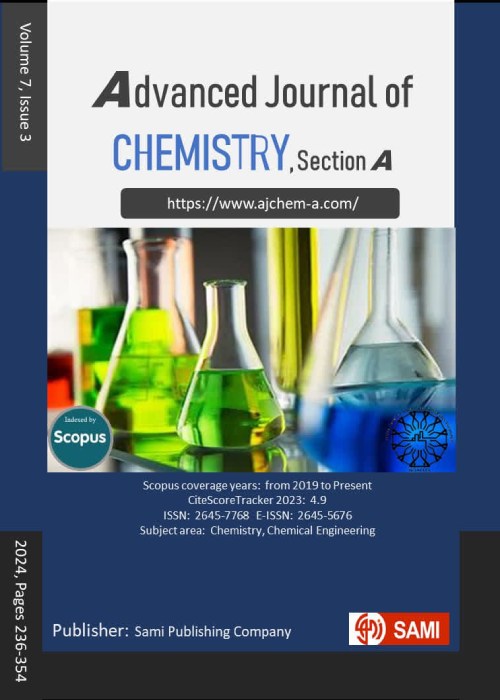فهرست مطالب
Advanced Journal of Chemistry, Section A
Volume:1 Issue: 1, Summer 2018
- تاریخ انتشار: 1397/06/10
- تعداد عناوین: 6
-
Pages 1-6An efficient and facile procedure has been developed for the ring opening of epoxides with nitrogen heterocycles such as indole and imidazole in the presence of Caro's acid-silica gel (CA-SiO2) as catalyst in solventless system. The reactions were administered underneath Solvent-free conditions. The current methodology offers many benefits like good yields, easy procedure, simple work-up and ecofriendly reaction condition. The catalyst is well ready, stable and economical underneath the reaction conditions.Keywords: Regioselectivity, Indole, Imidazole, Epoxide, Caro's acid-silica gel
-
One-Pot Synthesis of Tetracyanocyclopropane Derivatives Using Hexamethylenetetramine-Bromine (HMTAB)Pages 7-11Herein a direct method for synthesis of tetracyanocyclopropanes by the treatment of carbonyl compounds, malononitrile and hexamethylenetetramine-bromine (HMTAB) is described in the presence of catalytic amount of DABCO in ethanol media at room temperature.Keywords: Tetracyanocyclopropane derivatives, hexamethylenetetramine-bromine (HMTAB), DABCO
-
Pages 12-31A quantitative structure–retention relation (QSRR) study was conducted on the retention times of 160 pesticides and 25 environmental organic pollutants in wine and grape. The genetic algorithm was used as descriptor selection and model development method. Modeling of the relationship between selected molecular descriptors and retention time was achieved by linear (partial least square; PLS) and nonlinear (kernel PLS: KPLS and Levenberg-Marquardt artificial neural network; L-M ANN) methods. The QSRR models were validated by cross-validation as well as application of the models to predict the retention of external set compounds, which did not have contribution in model development steps. Linear and nonlinear methods resulted in accurate prediction whereas more accurate results were obtained by L-M ANN model. The best model obtained from L-M ANN showed a good R2 value (determination coefficient between observed and predicted values) for all compounds, which was superior to those of other statistical models. This is the first research on the QSRR of the compounds in wine and grape against the retention time using the GA-KPLS and L-M ANN.Keywords: grape, Wine, Pesticide Residue, Organic pollutants, GC×GC–TOFMS, Quantitative structure–retention relationships
-
Pages 32-38
In the current study, a new model for micro-scale cooling systems is presented. The small-scale refrigerator is modeled by engraving channels and a micro nozzle on the sides of a rectangular glass. The system has the capability to reduce the temperature from 300K to 80 in 5 seconds using nitrogen as the working fluid. The model consists of three elements, heat exchanger, nozzle and expansion tank and all the parts of the cooling system is stationary. For this novel model, pressure drop through the channels and nozzle sections is presented and by using these information, temperature drop through the nozzle is obtained regarding the high Mach number at the throat of the convergence-divergence micro-nozzle. Due to the characteristics of this in-plane micro-nozzle, the heat exchange is modeled through the time in the glass, and temperature of the cooling system is reported.
Keywords: Micro-miniature cooler, Joule Thomson cooler, heat transfer characterization, performance analysis, micro cooler -
Pages 39-55
A new and easy to fabricate voltammetric biosensor for acetaminophen determination was developed based on horseradish peroxidase (HRP) trapped between silica sol-gel film and multi-walled carbon nanotubes on glassy carbon electrode. Acetaminophen determinations were carried out in presence of H2O2 as enzyme activator. The modified electrode showed excellent electrocatalytic activity and rapid response to acetaminophen in the presence of H2O2 as enzyme activator. Various parameters influencing the biosensor performance such as amount of enzyme, H2O2 concentration, potential scan rate and pH have been investigated. Under the optimal conditions, a wide linear range of 1.85×10−6 to 2.7×10−3 M for acetaminophen determination was obtained. Limit of detection was calculated about 18 nM and sensitivity was about 220 nA/µM. Furthermore, the proposed biosensor was successfully examined for simultaneous determination of acetaminophen with uric acid (UA) and folic acid (FA) as prevalent interferes. The proposed biosensor showed satisfactory stability for 3 weeks and applicability of developed biosensor was confirmed with accurately evaluation of acetaminophen in real samples such as urine and tablet.
Keywords: Biosensor, Horseradish peroxidase, Acetaminophen, Enzyme Immobilization, Multi-walled carbon nanotube, Simultaneous determination -
Pages 56-65
Maleic anhydride (MAN) copolymers with methyl methacrylate, ethyl methacrylate, methyl acrylate, ethyl acrylate, and butyl acrylate monomers at 1:3 mole ratios were synthesized by free radical polymerization in the presence of azobis(isobutyronitrile) as initiator and dry ethyl acetate as solvent. Copolymer compositions were obtained using related proton nuclear magnetic resonance (1HNMR) spectra, and the polydispersity of the copolymers was determined by gel permeation chromatography. Then, a solution of 2-amino ethyl benzoate salt as a nucleophilic reagent reacted through the ring opening of anhydride groups in copolymers resulting to modified copolymers Iab to Vab. All the prepared polymers were characterized by Fourier transform infrared and1H NMR spectroscopic techniques. The glass transition temperature (Tg) of all copolymers before and after modification was determined by dynamic mechanical thermal analysis (DMTA). It was shown that chemical modification of MAN copolymers with 2-amino ethyl benzoate substituents as side chains decreased the free volume of the polymers, and therefore, the rigidity and Tg are increased.
Keywords: Chemical modification, Infrared spectra, dynamic mechanical thermal analysis (DMTA), thermo-gravimetric analysis (TGA), Maleic anhydride (MAN) copolymers


